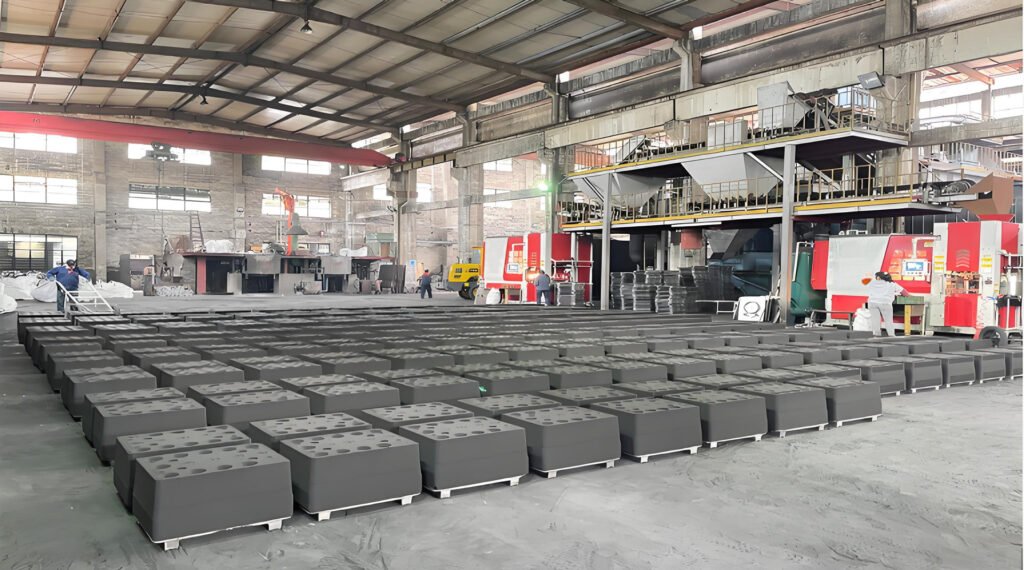Flaskless green sand molding machines have transformed traditional foundry processes by eliminating the need for conventional flasks (molding boxes).
This innovative approach offers numerous advantages:
- Reduced equipment costs (no flask maintenance/replacement)
- Space savings in the foundry
- Faster mold production cycles
- Improved dimensional accuracy of castings
What Is Flaskless Green Sand Molding?
Unlike conventional molding methods that use flasks (metal frames to hold the sand mold), flaskless molding machines create molds directly within the machine using pre-set patterns. The machine compresses green sand — a mixture of sand, clay, and water — around a pattern to form the mold halves. These halves are then joined and moved along the production line for pouring.
Flaskless Green Sand Molding Machine Key Features
Flaskless Design
Eliminates the need for handling and storage of flasks, reducing cost and complexity.
High Automation
Fully automated operation including mold forming, pattern ejection, and mold conveyance ensures consistent cycle times and reduces labor costs.
Compact Structure
Space-saving design makes it suitable for foundries with limited floor space while still allowing high-volume output.
Fast Cycle Time
Rapid mold-making capabilities support mass production requirements, ideal for automotive and machinery industries.
High Mold Accuracy
Uniform compaction and precise alignment of mold halves contribute to high dimensional accuracy and better surface finish of castings.
Flaskless Green Sand Molding Machine Applications
The Flaskless Green Sand Molding Machine is widely used in:
- Automotive industry: Engine blocks, brake components, transmission housings
- Agricultural machinery: Gears, housings, brackets
- General machinery: Pumps, valves, flanges, and bearing housings
Benefits
- Cost-Effective: Reduced tooling and operational costs due to flaskless design.
- Increased Output: High-speed molding meets the demands of modern mass production.
- Cleaner Operation: Better dust and sand management with enclosed systems.
- Improved Casting Quality: Reduced mismatch and sand defects enhance the final product.
- Flexible Production: Suitable for a wide range of casting sizes and part geometries.

Why Choose Flaskless Green Sand Molding Machines for Your Foundry?
Flaskless green sand molding machines have become a cornerstone in modern foundries due to their efficiency, cost-effectiveness, and adaptability. Below are key reasons to adopt this technology:
1. High Production Efficiency
- Speed: These machines achieve 80–200 molds per hour, significantly outpacing traditional methods. Automation minimizes manual intervention, ensuring uninterrupted production cycles.
- Consistency: PLC-controlled systems (e.g., Siemens or Omron) ensure precise mold formation and repeatability, reducing downtime.
2. Improved Casting Quality
- Sand Performance: Green sand’s moisture and clay content enhance mold strength and gas permeability, reducing defects like porosity or sand inclusions. Studies show that sand quality directly impacts rejection rates in casting.
- Vertical Sand Feeding: Suspended shot sand systems eliminate “shadow defects” by ensuring uniform compaction, critical for complex castings like valves and automotive parts.
3. Flexibility Across Applications
- Adjustable Parameters: Operators can customize casting height, compaction pressure, and mold dimensions (e.g., up to 1100×1100mm) to suit diverse products, from manhole covers to hydraulic components.
- Quick Template Replacement: Simplified mold changes enable rapid transitions between product lines, ideal for small-batch or customized orders.
4. Cost-Effective Operations
- Reduced Labor: Fully automated lines eliminate flasks and manual sand handling, cutting labor costs by up to 50%.
- Energy Savings: Energy-efficient designs (e.g., 18.5 kW motors) and optimized sand reuse lower operational expenses.
5. Sustainability and Space Optimization
- Eco-Friendly: Closed-loop sand recycling minimizes waste, aligning with green manufacturing trends.
- Compact Footprint: Horizontal parting designs require less floor space compared to vertical systems, ideal for foundries with limited area.
Advantages of Flaskless Green Sand Molding Machines Over Traditional Methods
The foundry industry has witnessed significant technological advancements with the introduction of flaskless green sand molding machines. These systems offer substantial improvements over traditional flask molding methods in terms of efficiency, cost-effectiveness, and environmental impact.
Key Advantages
1. Elimination of Flask Usage
Traditional molding requires metal or wooden flasks to contain the sand mold during pouring and cooling. Flaskless systems remove this requirement by using high-pressure compaction to create self-supporting molds. This reduces material costs and eliminates flask maintenance.
2. Higher Productivity
Flaskless machines operate with automated cycles that are faster than manual or semi-automated flask molding. The continuous production line minimizes downtime between molds, increasing output by 30-50% compared to conventional methods.
3. Space Efficiency
Without flasks, storage and handling space is significantly reduced. Traditional methods require large areas for flask storage and transportation, while flaskless systems optimize floor space in foundries.
4. Improved Sand Utilization
Green sand in flaskless systems is recycled more efficiently with consistent compaction, reducing waste. Traditional methods often lead to sand degradation due to uneven handling and flask-related contamination.
5. Energy and Labor Savings
Automated flaskless molding reduces reliance on manual labor for flask handling and sand ramming. Energy consumption is lowered due to streamlined processes and fewer mechanical components.
6. Better Casting Quality
High-pressure molding in flaskless systems produces denser, more uniform molds with fewer gas defects. Traditional methods may suffer from inconsistencies due to variable manual compaction.
Conclusion
The Flaskless Green Sand Molding Machine represents a significant advancement in modern foundry technology. By removing the need for traditional flasks and increasing automation, it boosts efficiency, reduces costs, and improves the overall quality of cast parts. It’s a smart investment for foundries aiming to modernize and stay competitive in today’s fast-paced manufacturing environment.

